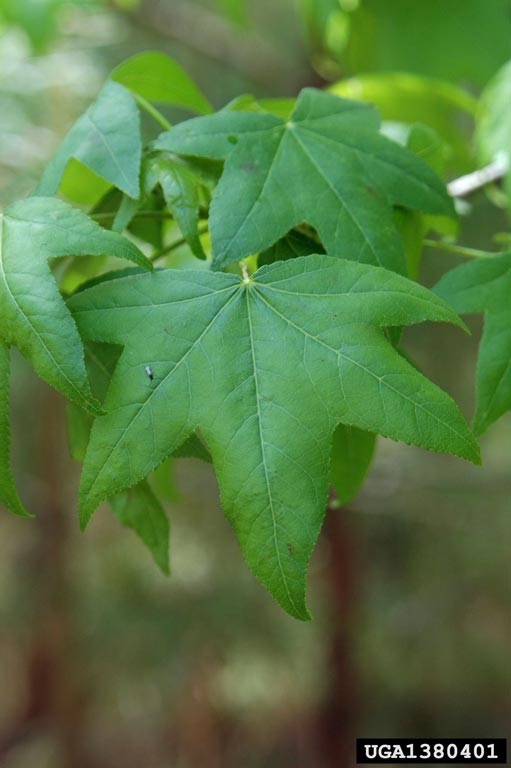 Liquidambar Trees - July 10, 2013 Jeff Schalau, Agent, Agriculture & Natural Resources University of Arizona Cooperative Extension, Yavapai County The Liquidambar tree (Liquidambar styraciflua) is native to the warm temperate areas of the southeastern United States and tropical montane (cloud forest) regions of Mexico and Central America. This tree is well suited to the mid-elevations of north central Arizona including Prescott, Payson, and the Verde Valley. They are not commonly planted in our region, but the specimens that I’ve seen are doing well. They do require supplemental irrigation and are not a replacement for more drought-tolerant species such as mesquite and desert willow. However, Liquidambar trees do produce excellent fall colors ranging from burgundy and red to orange and yellow. Before rushing to plant a Liquidambar tree, you should consider your soils and the tree’s irrigation requirements. Highly alkaline, rocky soils are probably not best suited for Liquidambar. Granitic or sandstone derived soils as well as streamside alluvium should be less alkaline and provide a more hospitable soil environment for these trees. I would avoid limestone derived soils for this tree. Irrigation requirements would be comparable to ash or Arizona cypress and, if drip irrigation is used, I would recommend adding emitters as the tree matures. Liquidambar styraciflua is also known as sweetgum tree. It was introduced to England in 1681 where it was planted at the palace gardens in Fulham. The name “Liquidambar” was first given by Linnaeus in 1753 from Latin: liquidus or fluid and the Arabic ambar in allusion to the gum which exudes from the tree. Its specific epithet styraciflua refers to “styrax” also meaning plant resin. At first glance, you might mistake a Liquidambar for a maple. The leaves are palmate (almost star-shaped) and have alternate arrangement on the stem. Maples can be differentiated by their opposite leaf arrangement. In alternate leaf arrangement, the leaves are single at each node and borne along the stem alternately in an ascending spiral. In opposite-leaved plants, the leaves are paired at a node and borne opposite to each other. By the way, leaf arrangement is an important feature that can help when trying to identify plants. In general, most plants have alternate leaf arrangement and remembering which plants have opposite leaf arrangement will make identification much easier. Some plants with opposite leaf arrangement include maples, ashes, privets, Viburnums, elderberries, and olives. Alternate leaf arrangement is far more common. Liquidambar trees can get 60 to 75 feet high in their native range, but I have not seen many over about 30 to 35 feet in Arizona. It is deciduous and it most often shaped like a pyramid. Liquidambar has glossy, green leaves with inconspicuous flowers and the fruits are round and covered with soft, rounded (not prickly) spines. It prefers full sun and is hardy to USDA Plant Hardiness Zone 5B (-10 to -15 degrees F). Another interesting feature of some liquidambar cultivars are flattened, corky bark projections on the trunk and larger stems. Many cultivars are sold and ‘Moraine’ is said to be the hardiest cultivar tolerating -25 degrees F. I could not locate and references to cultivars tolerant of alkaline soils. I have seen some nice specimens at Tlequepaque in Sedona. Disease problems are not known to occur in north central Arizona, but this could be due to their relative scarcity. In their native range, they are known to be impacted by some fungal diseases much like aspens, cottonwoods and willows are impacted by fungal diseases here. Some potential insect pests of Liquidambar include fall webworm, cottony cushion scale, and tent caterpillars. All can be found in our area. However, cottony cushion scale is the worst of those listed. If you decide to plant a Liquidambar, remember to consider its mature size and keep it away from buildings and check for underground utilities before planting. Do not amend the soil or backfill with fertilizers or compost. Plant in native soil and apply organic mulch to the soil surface to conserve moisture and mitigate weed growth. Irrigate it regularly, especially during establishment. If any Arizona readers have Liquidambar trees, please send me an e-mail letting me know about your successes or failures. Follow the Backyard Gardener on Twitter – use the link on the BYG website. If you have other gardening questions, call the Master Gardener help line in the Camp Verde office at 928-554-8999 Ext. 3 or e-mail us at cottonwoodmg@yahoo.com and be sure to include your name, address and phone number. Find past Backyard Gardener columns or provide feedback at the Backyard Gardener web site: http://cals.arizona.edu/yavapai/anr/hort/byg/. |